Sony Vaio Z2: Everything is Peripheral
by Dustin Sklavos on February 13, 2012 12:55 AM ESTBattery Life
The 45Wh battery that comes standard with the Sony VAIO Z2 could probably seem at least a little anemic, but we've seen there's a decent amount of latitude with Sandy Bridge when it comes to ekeing out running time. Sony's own VAIO SB produced a tremendous amount of running time off of its main battery, so much so that the value of the battery slice for that notebook seemed like a genuinely questionable value. So how well does the Z2 handle our battery tests?
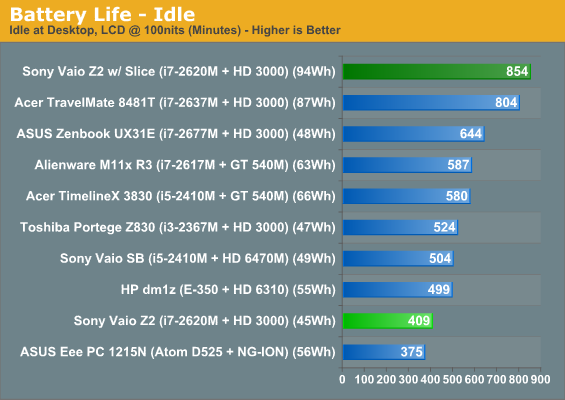
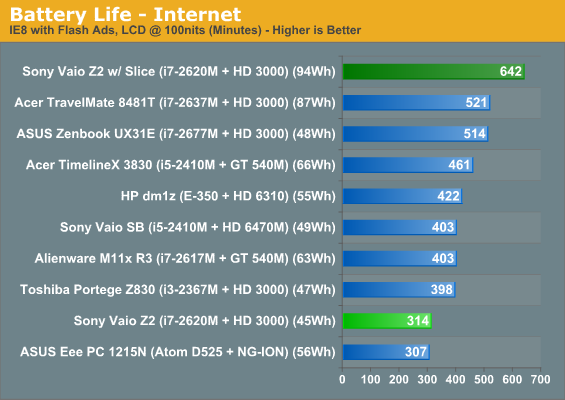
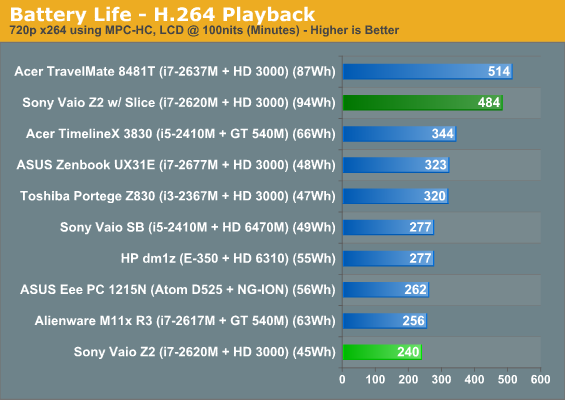

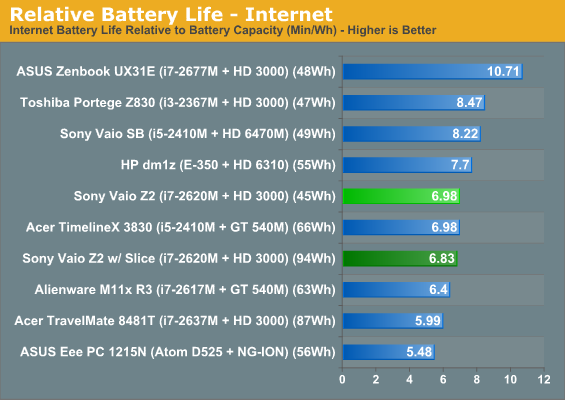
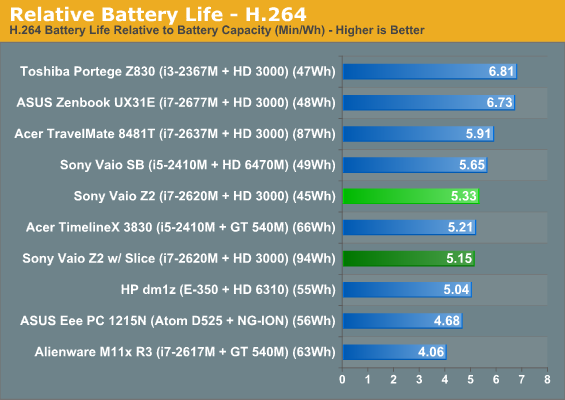
It may not be at the top of the charts, but the Z2 also features a 35W processor instead of the usual 17W low voltage chips found in ultrabooks and other ultraportables. With that taken into account, the Z2 suddenly looks a lot rosier. Add the battery slice to the equation and you're suddenly looking at the vaunted "all-day running time." If ten hours of productivity isn't enough for you, consider taking a break.
Noise and Heat
Where things start to fall apart again for the Sony VAIO Z2 is specifically in noise. Internal heat is a little higher than we like to see, but it's the fan noise that becomes troublesome. Sitting at a normal distance from the notebook, it produces about 43.3dB under load, though fan noise ramps up very gradually. That's not the real issue, though; the real issue is just how high pitched the fan noise gets when the system is under full load. During testing there were times when the fan from the Z2 actually hurt my ears. Thankfully, under load the external dock doesn't produce much in the way of fan noise and is easily drowned out by the Z2.

This is, of course, a good part of the reason why the fan noise is so nasty: even running at full tilt, the fan has a hard time keeping the i7-2620M's core temperatures under a blistering 90C. While the surfaces of the Z2 never feel too hot, Sony may well have been overreaching trying to put a 35W processor in this chassis.










88 Comments
View All Comments
JarredWalton - Monday, February 13, 2012 - link
I've been trying to include metric on all my laptop specs for a while, but I guess I didn't pass the message along to Dustin. Consider him flogged for being an Imperialist scum. ;-)Solandri - Monday, February 13, 2012 - link
The point isn't that you can do the conversion yourself on a free web site. The point is that if the article author does the conversion once, then tens of thousands of readers don't have to do the same conversion themselves. 60 seconds saved * 50,000 readers = 1 month of aggregate time saved.Zoomer - Tuesday, February 14, 2012 - link
Metric is a SI standard. Imperial units aren't. Too bad.Sea Shadow - Monday, February 13, 2012 - link
I can't help but feel like this article was lost in time somewhere as a lot of things just don't add up.Correct me if I am wrong, but I could have sworn that the last Z to have the optical drive was 2 generations ago, that or at least it was 2 years ago. The Z sold last year didn't have an optical drive and was nearly identical in body styling.
Also the current Z doesn't ship with a 2620M, as the option was replaced by the 2640M a while back.
The gripe with the 4x PCI-E link seems trivial as that is all that Light Peak can support... Last I checked, the interface currently supports 10 Gbit/s. So what else is Sony supposed to do?
Not that it matters much, as people have been using their express card slot to make their own E-GPUs for quite some time now. I have a Lenovo x220t with an E-GPU and I can confirm that even a 1x link is enough for even BF3. Others have performed scaling tests and found that while there is a marked difference between 1x and 2x, anything above that has a minimal impact. So even a 4x link is plenty sufficient.
For information on E-GPUs check out this page: (NOTICE:You are responsible for your equipment)
http://forum.notebookreview.com/gaming-software-gr...
Also there is a typo on the first page:
1st page processor model is listed as " Core i7 2720M" but everywhere else it is listed as 2620M
I won't hold the typo against you, but this review feels out of date, and in my opinion does not meet the usual standards of an Anandtech review.
Rick83 - Monday, February 13, 2012 - link
Also, it would have been interesting to see if performance of the graphics card changes when using an external screen, attached directly to the dock.That way the framebuffer won't have to be flushed back (via the displayport segment of LP/TB? or PCIe?) to the laptop, and more bandwidth would be free on the link to the dock. If there truly was a bandwidth limit (at v2x4 and mid-end mobile graphics, there shouldn't be) it might have less impact in that case.
In the end, for me the SSD-RAID kills the deal. A single SATA 3 high-end SSD would have been plenty of fast enough, and would have instead allowed to either beef up cooling, allow swappable RAM, or just lower the price. Unless they are using a highly specific daughterboard for the SSD to save on space, there really is no reason in this day and age to stick two cheap SSDs where one good one would do the trick.
DoctorG - Monday, February 13, 2012 - link
If I remember correctly, LP is bi-directional, and most graphics card bandwidth is used to send data to the card, so sending back the framebuffer doesn't impact the performance all that much. There is a noticeable performance difference between the internal vs. external screen though, which I think has to do with the graphics drivers and extra processing required to render something back to the internal display.And yes, the SSD "raid" isn't two drives in the normal sense of the word -- it's two controllers, but they are one unit, and designed to be extremely thin. Also, this laptop came out more than six months ago, when the current, high-end controllers did not have as good a track record as they do now . . . I don't know Sony's reason behind the decision or anything, but those are my best guesses.
JarredWalton - Monday, February 13, 2012 - link
I'll see if Dustin still has the Z2 and can check the performance using an external display. As for the out-of-date aspect, that's mostly a factor of Sony not having sent us a review unit until we met with them at CES. The Z2 we're reviewing here technically launched around July last year, so it is six months old -- though it's still on sale. Granted, the CPUs were refreshed to the 2640M, 2530M, etc. but the extra 100MHz speed bump hardly matters.Anyway, while the hardware is six months old, we have had a LOT of requests to review the VAIO Z series, so when we finally got a chance to do so we took it. Hopefully, we can get the Ivy Bridge version reviewed closer to launch -- and hopefully it will address a few of our concerns with this model.
As far as the PCIe bandwidth being limited by Light Peak, that's fine. It's not really Sony's fault that Light Peak can't carry more than an x4 link, but it is their fault for choosing to use the technology this way. It seems reasonable that the bandwidth isn't so much a problem for rendering on an external display, but for some reason it causes some performance degradation with the internal display. Whatever the cause, though, what's important is that we point out the level of performance you can expect in a reasonable use case, and here the Z2 GPU is only fast enough for our "Value" (~medium detail) settings.
jonyah - Monday, February 13, 2012 - link
Yep, you're wrong on the model. the VPC-Z1, was the previous model. Sony usually updates the Z around June. So it won't be long till the Z3 is out. This article is just late since the Z2 has been around since last June. The Z is usually the last model of Sony's notebook line to be updated because they actually do some real engineering to fit everything inside such a small frame.clarkn0va - Monday, February 13, 2012 - link
I thought ultrabooks were supposed to be small and beautiful. 2.5 lbs is decently light, but this thing looks thicker than my 3-year old Timeline. Leave it to Sony to bring a knife to a gun fight.jonyah - Monday, February 13, 2012 - link
That's because the pictures show it with the optional battery slice attached. Remove the slice and you have a nice thin notebook. Not as thin as an ultrabook but also not as slow as one (I'm still waiting for an ultrabook that has more than 4gb of memory).